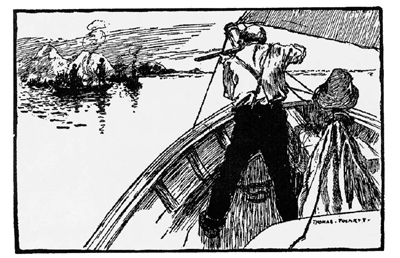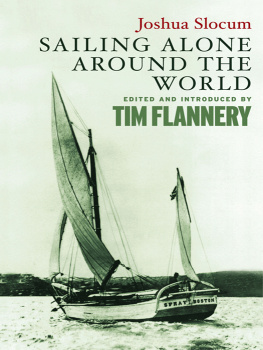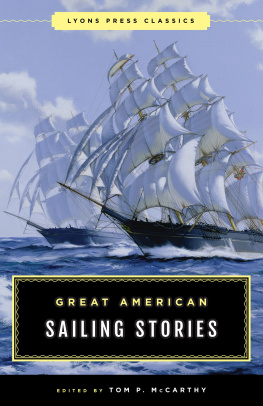
SAILING ALONE AROUND THE WORLD

A brush with Fuegians.
Tim Flannery was born in Melbourne in 1956. He is director of the South Australian Museum and has made contributions of international significance to the fields of palaeontology, mammalogy and conservation.
Mammals of New Guinea
Tree Kangaroos: A Curious Natural History (with R. Martin, Peter Schouten & Alex Szalay)
The Future Eaters
Possums of the World: A Monograph of the Phalangeroidea (with Peter Schouten)
Mammals of the South West Pacific and Moluccan Islands
Watkin Tench, 1788 (ed.)
John Nicol, Life and Adventures 1776-1801 (ed.)
Throwim Way Leg: An Adventure
The Explorers (ed.)
The Birth of Sydney (ed.)
Terra Australis: Matthew Flinders Great Adventures in the Circumnavigation of Australia (ed.)
The Eternal Frontier: An Ecological History of North America and Its Peoples
A Gap in Nature: Discovering the Worlds Extinct Animals (with Peter Schouten)
John Morgan, The Life and Adventures of William Buckley (ed.)
The Birth of Melbourne (ed.)
Grateful acknowledgment is made to the New Bedford Whaling Museum to reproduce the cover image. For information on the Joshua Slocum Society International visit www.joshuaslocumsocietyintl.org
textpublishing.com.au
The Text Publishing Company
Swann House, 22 William Street
Melbourne Victoria 3000
Australia
Copyright Tim Flannery 2003
All rights reserved. Without limiting the rights under copyright above, no part of this publication shall be reproduced, stored in or introduced into a retrieval system, or transmitted in any form or by any means (electronic, mechanical, photocopying, recording or otherwise), without the prior permission of both the copyright owner and the publisher of this book.
Sailing Alone around the World was first published in book form in 1900.
Strange, but True: Life and Adventures of Captain Thomas Crapo and Wife was first published in book form in 1893.
This edition published by Text Publishing 2003
Printed and bound by Griffin Press
Design by Chong Weng-ho
Typeset in Janson by Midland Typesetting
National Library of Australia
Cataloguing-in-Publication data:
Slocum, Joshua, b. 1844.
Sailing alone around the world.
eISBN 9781921799396.
ISBN 9781877008573.
1. Slocum, Joshua, b. 1844 - Journeys. 2. Spray (Sloop). 3. Voyages around the world. 4. Sailing, Single-handed.
I. Flannery, Tim, 1956- . II. Title.
910.45
Length
1 inch = 2.5 centimetres
1 foot = 30.5 centimetres
1 yard = 0.914 metres
1 mile = 1.61 kilometres
Mass
1 ounce = 28.3 grams
1 pound = 454 grams
1 ton = 1.02 tonne
Volume
1 gallon = 4.55 litres
Temperature
C = 5/9 (F -32)
Depth
1 fathom = 1.83 metres
Bark: a sailing vessel with three or more masts, square-rigged on two masts, excepting the aftermost mast, which is fore- and aft-rigged.
Dory: a small flat-bottomed sailing vessel, most often used for fishing.
Drogue: a sea anchor, rather like a bucket thrown over the bow.
Sloop: a sailing vessel with one mast carrying fore and aft sailsa mainsail and headsail.
Schooner: a sailing vessel with two or more masts, with the aftermast as tall or taller than the other(s).
Windjammer: a sailing ship.
DISCOVERING
CAPTAIN SLOCUM
Tim Flannery
A mong the many classics of the sea, few books can rival Joshua Slocums Sailing Alone around the World for sheer audacity, adventure and beauty of language. Although written little over a century ago it is redolent of an even earlier age, and has made so great an impression that thousands have been moved to emulate Slocums great feats. Indeed, Slocum societies continue to thrive around the world.
Until James Cook conquered the affliction of scurvy with his barrels of sauerkraut, circumnavigating the globe inevitably killed many of those who attempted it. Of the 267 souls who first set out to achieve the task with Ferdinand Magellan, just eighteen survived, and when they returned in 1521 they were so worn down by the three-year voyage that each man appeared leaner than an old worn-out hack. So dangerous was the undertaking that for centuries the major European naval powers considered it acceptable if only one or two of every ten sailors should die during each year of such a long voyage. Yet a little over a century after Cook met his untimely death on Hawaii in 1779, the remarkable Joshua Slocum set out to sail around the worldalone. He was superbly qualified for the task, for by then he had spent thirty-seven of his fifty-one years at sea.
It is difficult for those who are familiar with the feats of solo sailing performed by Sir Francis Chichester, Kay Cottee and others to recapture the bravado of Slocums venture. When he set out in 1895 his voyage was truly a step into the wild blue yonder. He would not be heard of for months at a time, and for most of the voyage was utterly out of reach of help. As audacious as the venture was overall, it was the little things that people wondered at. How, the land-lubbers asked, during a voyage which lasted more than three years, would Slocum steer his vessel and still find sleep? How would he avoid hurricanes, and the madness brought on by solitude? But to a man of Slocums sea experience, difficulties that seemed insurmountable to others were simply matters to be solved by common sense.
In many ways Slocums whole life can be seen as preparation for his remarkable solo voyage. He was born beside the Bay of Fundy, Nova Scotia, on 20 February 1844, and like so many lads of his day he ran away to sea at a tender age. But his stint as a cook on a fishing schooner at age fourteen was not a success, and he returned home to a thrashing from his father. Two years later he left for blue waters, and this time would never see home again. Although his entire formal education comprised just three years at a village school, which he left at the age of ten, Slocum was a natural student. He taught himself how to navigate from John William Nories Epitome of Navigation and spent a lifetime closely observing the sea. He would later say of himself, I was born in the breezes and I had studied the sea as perhaps few men have studied it, neglecting all else. Such was his nautical competence that at eighteen he was appointed second mate on the bark Agra.
When she pulled into San Francisco harbour in 1864, the twenty-year-old Slocum, now chief mate, decided to make the town his home port. He became an American citizen in order to pursue fishing and sealing, and five years later was given his first commanda coastal schooner. Within a year he found himself captain of the bark Washington, with a general cargo, on his way to Sydney, Australia.
In that beautiful harbourside city something very special happened to Joshua Slocum, for our young wanderer fell in love. The romance with Virginia Walker of 19 Buckingham Street, Strawberry Hills (near Central station) was a whirlwind affair. On 31 January 1871, a matter of weeks after they first met, the twenty-six-year-old sailor and his nineteen-year-old sweetheart were married in the church of the Holy Trinity at the Garrison on Lower Fort Street. It was a suitably maritime location to celebrate a marriage that would be spent almost entirely at sea.









